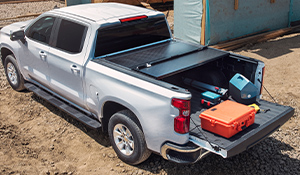1997 Lada Niva Review
History
The Lada Niva was fully imported from Russia, where it dated back to the mid-70s. It was initially designed as a serviceable vehicle to cope with the conditions experienced in a Russian winter. Its design brief may well have been to provide a comfortable passenger vehicle for 4 passengers with off-road capability, as this is precisely where the vehicle shone. It was not a workhorse vehicle, and based on size alone with four passengers aboard had minimal cargo area.
Typically Russian, it was plain and practical, utilising constant 4WD with lockable centre differential. Only one 4WD model was available, this being a short wheelbase, two-door, initially powered by a 4-cylinder 1570cc engine with four-speed transmission and low range gearing.
Affordable and unpretentious
The Lada Niva is easily distinguished by it's squarish appearance and unique shape and styling. Similar to the evolution of the Jeep, the Lada had been continually upgraded, rather than bringing out costly new models.
It is a two-door car; squarish in shape, with practical styling, best described as 'plain'. This is not to denigrate the vehicle in that it was never designed to be anything else and fulfils its role admirably.
The body panels were robust and there was no exposure of vulnerable components. A sump bash plate and an optional hinged bash plate, which could be fitted to protect the whole underbody, provided underbody protection. Designed for rough terrain travel, rather than city touring this was reflected with excellent ground clearance, and permanent 4WD.
Despite its ten-plus year's availability in Australia, the Lada was always a relative rarity on our roads. Considering its affordability and competent off road credentials this was surprising. Its plain appearance simply did little to endear it to customers in the face of immediate cheap competition from Suzuki and Daihatsu.
Lada in Australia
The Lada Niva was first displayed in Australia at the 1983 Melbourne Motor Show. Graeme West brought the vehicle to Australia after visiting Russia and finalising a deal, which saw VAS agree to produce a right-had drive version of the Lada. 450 Lada's arrived in Australia accompanied by 15 tonnes of spare parts. The Lada drew attention to it's presence through participation in many Australian off-road racing events, where it showed it was a capable and tough off-roader, more than able to hold it's own against more fancied competition.
The Federal Government then entered the picture and nearly finished the Lada's Australian debut, by declaring that because of its unique monocoque construction that it could not be regarded as a commercial vehicle, but as a passenger car. This immediately introduced an import quota and greatly increased tariffs that threatened to cripple the fledgling company. The Lada faded from the scene for a few years, before being rejuvenated in 1997 by a new Perth based distributor Lada Australia.
Models
Essentially there was only one Lada model, but Lada Australia created three spec levels by adding additional equipment.
The top of the range vehicle was given the dubious name of "Bushman" in an attempt to win local business. Below it was the Niva GL and an entry-level no-frills machine. A Lada 4WD utility also appeared for a limited time.
Although considered a basic 4WD, the Lada featured some top-end design features, which it shared with the Range Rover. Special features of the Lada include its one-piece monocoque construction, whereby it is not constructed on a separate chassis. In common with the Rangie the Lada had permanent 4WD with a lockable centre differential. It also had coil spring suspension all round. Independent front suspension and live rear axle, coupled with long travel coil springs on all fours and double acting shocks provided a good ride in all conditions. Being a short wheelbase, and with good ground clearance, the Lada had excellent approach and departure angles. It was fitted with 16-inch steel radials. The Lada was a two-door vehicle with a rear-lifting hatch.
A new 1.7-litre single camshaft engine powered the 1997 Lada "Bushman". This 1700cc unit delivered 58kW of power and a modest 127Nm of torque. The Bushman was equipped with a GM supplied fuel injection system. It was mated to a five-speed manual transmission, with CV joints used instead of universal joints in the drivetrain.
Interior
While sharing some mechanical traits of the Range Rover, it was contrasting interiors that soon brought any notion of comparison down to earth!
The basic Lada's interior was basic, and functional, with a no-option black finish. Seats were finished in black vinyl, and there were black floor mats. Front bucket seats and a rear bench provided adequate comfort. The rear seat could be folded flat for added storage area. Instrumentation was good with tacho, oil and fuel gauges and various warning lights. A radio, two-speed heater/demister and headlight wipers were added features.
The Bushman enjoyed AM/FM stereo radio, sports steering wheel, tachometer and a choke warning light. 100-watt driving lights and alloy wheels also distinguished it. Air conditioning was a $2,000 extra on all models, but features such as central locking, ABS brake, power windows and mirrors were not available at all!
The 1997 Lada featured a new dash layout, with gauges enclosed in a rectangular binnacle in front of the driver. A centre console projected from the dash and hosed ventilation ducts, controls and radio.
While this model looked quite good in many respects it was the same basic four wheeler that had been built 14 years prior. Its interior was dated, finish quality ordinary and cargo area extremely limited.
Performance
The Lada was a far better performer off-road than on. It had a 23.5cm ground clearance and the coil suspension provided a good ride, although sometimes bouncy across rough terrain. Steering was heavy, especially at low speeds, while the 1700cc engine was barely adequate.












